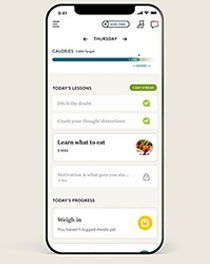By clicking on the product links in this article, we may receive a commission fee at no cost to you, the reader. Sponsorships and affiliate commissions help support our research so we can help you find the best products. Read our full affiliate disclosure here.
We've all been there. Despite exercising and watching what you eat, the elastic in your workout shorts seems to be as tight as your hamstrings. "Ninety-five percent of the active people I work with want to lose some weight," says Cassie Dimmick, M.S., R.D., a sports dietitian and running coach in Springfield, Missouri.
Getting lean requires the same trait that makes you get up at 5 a.m. for a workout: discipline. You need to be vigilant about your
health, your diet, and consistent with your exercise so that you maximize calorie burn, increase muscle mass, and decrease body fat. Luckily, it's easier than it sounds when you employ these tactics from dietitians and coaches. Get ready to lose.
NOOM helps you re-train your brain to develop lasting healthy lifestyle habits:



